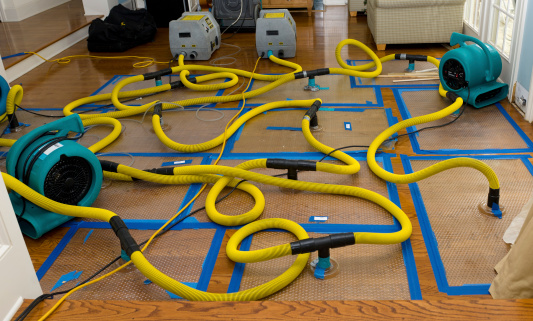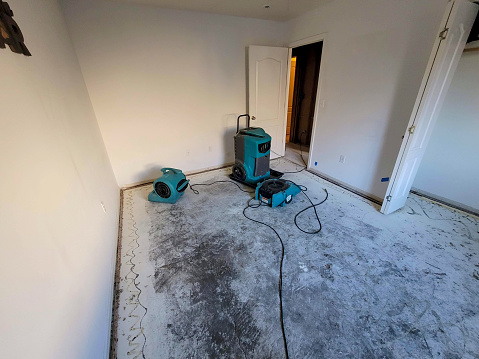When water damage strikes your home, the immediate priority is to remove the water and prevent further damage. After the professionals come in, extract the water, and leave drying equipment behind, you may feel like you’re well on your way to recovery. But here’s the catch—the drying process isn’t finished just because the visible water is gone. It’s only just begun.
Drying equipment such as dehumidifiers and air movers may be noisy and disruptive, but leaving them on is critical to ensuring your home is completely dry and preventing costly problems down the road. Shutting them off early can lead to serious consequences, both for the structure of your home and your health.
Let’s break down why it’s essential to leave the drying equipment running and why you need to communicate effectively with your water damage company during this process.
Why You Must Keep Drying Equipment Running
- Moisture Hides in Places You Can’t See
Once the standing water has been extracted, don’t be fooled into thinking your home is dry. Water can—and will—hide in porous materials like drywall, wood framing, and flooring. Even carpets, which may feel dry to the touch, can hold onto moisture deep in the fibers and padding. That’s where the drying equipment comes in.
Air movers and dehumidifiers are designed to pull out that hidden moisture and circulate dry air throughout your home. Shutting them off prematurely allows that moisture to stay trapped, which can lead to mold growth and even structural damage.
- Mold Growth Can Start Quickly
Mold is one of the biggest dangers of improper drying after water damage. According to the Environmental Protection Agency (EPA), mold can begin growing within 24-48 hours after water exposure. Mold isn’t just unsightly—it can pose serious health risks, especially for those with respiratory conditions or allergies. The noise of the drying equipment may be annoying, but it’s a small price to pay compared to the costs of mold remediation.
If the equipment is turned off too soon, you risk leaving moisture in your walls, floors, and ceilings, creating the perfect environment for mold to thrive. Once mold starts growing, it can spread quickly, leading to significant cleanup costs and potential health problems.
- Prevent Long-Term Structural Damage
Water can weaken the structure of your home over time. Wood, drywall, and even concrete can absorb moisture and swell, warp, or degrade. If left unchecked, this can result in serious structural issues, including damaged walls, sagging ceilings, and weakened flooring. In some cases, improper drying could even lead to foundational problems.
Professional-grade drying equipment is engineered to thoroughly remove moisture from the materials inside your home. By running these machines for the full recommended time, you’re ensuring that the structure is drying from the inside out. Cutting this process short can result in thousands of dollars in future repair costs.
Yes, It’s Noisy—But Turning The Equipment Off Is Not An Option
We get it. The noise from industrial drying equipment is not pleasant. It can be loud, disrupting your daily routines and making it difficult to live comfortably in your own home. But there are ways to manage the inconvenience.
- Talk to Your Water Damage Company
Open lines of communication are key. Let your water damage company know how disruptive the equipment is and ask if they have any recommendations for placement or different equipment. Many companies offer quieter models of air movers and dehumidifiers that could make the drying process less stressful. Additionally, ask about the timeline for drying so you can plan accordingly.
- Clarify the Drying Timeline
It’s natural to want the process to be over as soon as possible. Make sure you ask your water damage company for an estimated drying timeline so you know how long the equipment needs to stay running. If the timeline seems unclear or if the drying process takes longer than expected, communicate your concerns and get updates. Don’t turn off the equipment prematurely without consulting the professionals. They’ll tell you when the job is really done.
The Consequences of Turning Off Drying Equipment Early
Turning off the drying equipment too soon is a gamble you don’t want to take. The consequences can be much worse than the inconvenience of noise and disruption.
- Mold growth that can lead to long-term health risks and expensive remediation.
- Structural damage that weakens your home and results in costly repairs.
- Extended drying time if the equipment needs to be brought back in after shutting it off prematurely.
Conclusion: Communicate, Trust, and Dry Completely
While the drying equipment left behind by your water damage company may not be the most convenient or quiet, it’s absolutely essential to the restoration process. The noise is temporary, but the consequences of improper drying are long-lasting. By keeping the equipment running and working closely with your water damage professionals, you can ensure your home is completely dried and safe from future problems.
Don’t cut corners. Trust the experts, communicate your concerns, and follow through with the full drying process to protect your home and your health.


